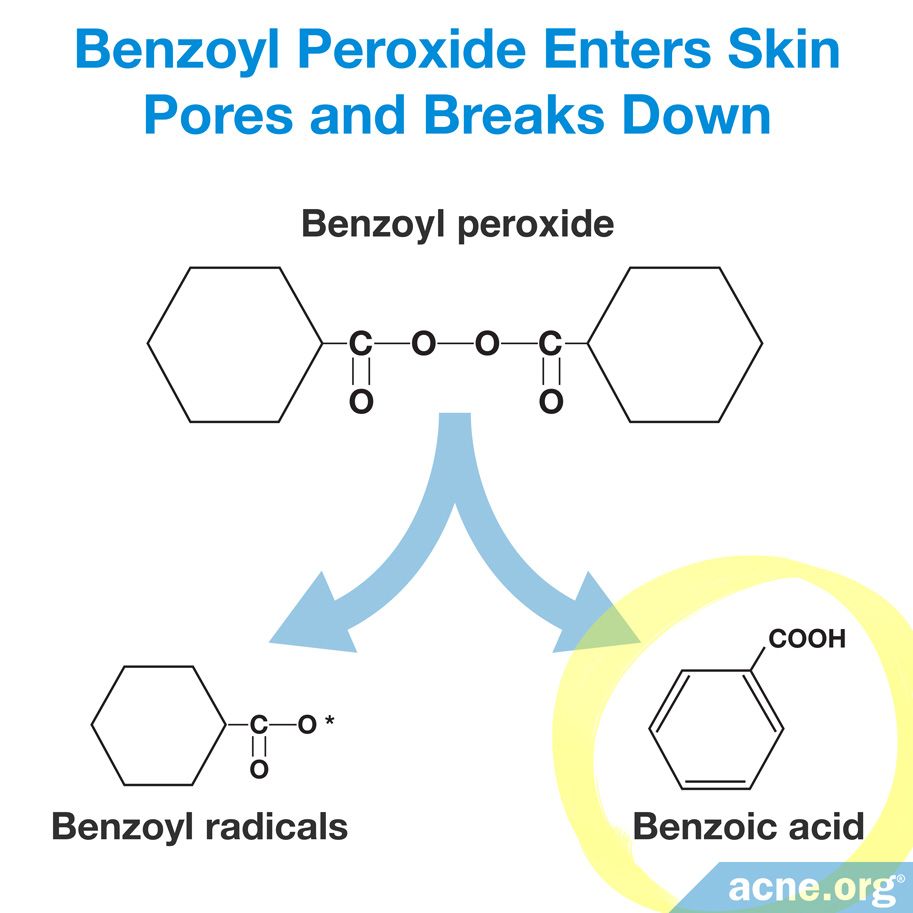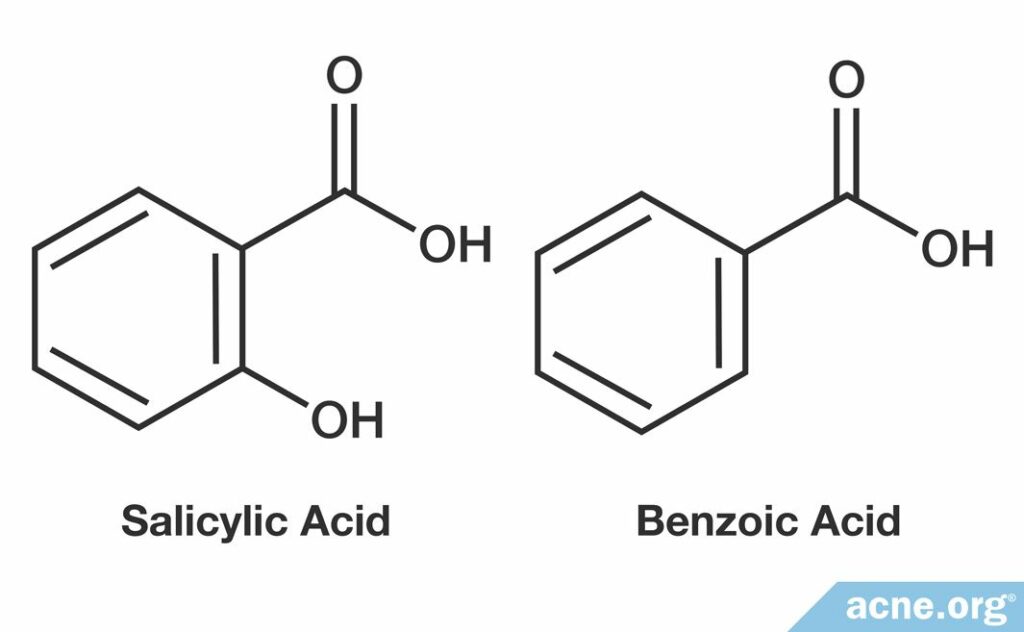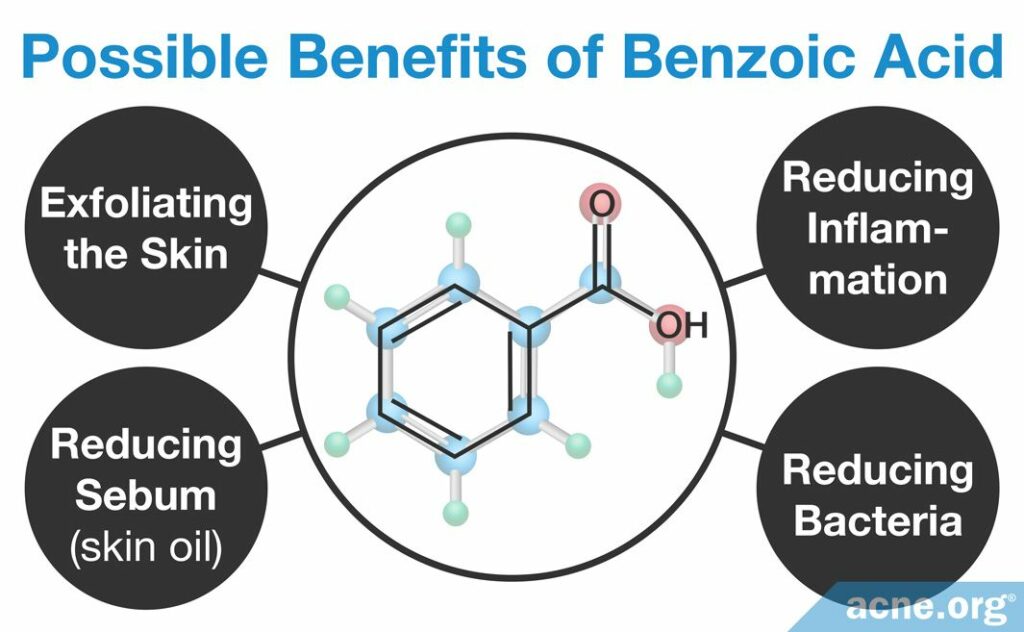Benzoic Acid Forms from the Breakdown of Benzoyl Peroxide on the Skin. Once it Forms, Benzoic Acid Is Hypothesized to Work Similarly to Salicylic Acid to Clear Acne.

The Essential Info
When benzoyl peroxide is applied to the skin, it breaks down into two parts:
- Hydrogen peroxide: Hydrogen peroxide works by killing acne bacteria (C. acnes).
- Benzoic acid: It is unclear exactly what role benzoic acid plays in clearing acne. Some believe it might work similarly to salicylic acid, a commonly used over-the-counter acne treatment by:
– Exfoliating the skin
– Reducing inflammation
– Clearing clogged pores
– Reducing bacteria

The Science
- Benzoic Acid’s Similar Chemical Structure to Salicylic Acid
- It is Unclear How Effective Benzoic Acid is at Clearing Acne
- Side Effects of Benzoic Acid
Benzoyl peroxide is a commonly used topical acne medication. When benzoyl peroxide is applied to the skin it breaks down into two components:

- Hydrogen peroxide: Hydrogen peroxide works by killing off acne bacteria (C. acnes).
- Benzoic acid: The exact effects of benzoic acid are still unknown.
Benzoyl peroxide is effective at clearing acne.1-4 But, researchers do not know whether the ability of benzoyl peroxide to clear acne is due to the bacteria-killing properties of hydrogen peroxide or might also be partly due to the unknown properties of benzoic acid.
Benzoic acid has a similar chemical structure to salicylic acid, another common topical acne medication that is somewhat effective at clearing acne. Therefore, it is hypothesized that benzoic acid may work in a similar way to salicylic acid, by:
- Exfoliating the skin
- Reducing inflammation
- Clearing clogged pores
- Reducing bacteria
To date, there is no direct scientific study that confirms this. Therefore, more research is needed to confirm that benzoic acid does indeed work to clear acne in a similar way to salicylic acid.
Outside of its potential medicinal role, benzoic acid is widely used as a preservative that is added to many foods, beverages, and skincare products.
When it comes to skincare products, the Cosmetic Ingredient Review Expert Panel has concluded that it is safe to include benzoic acid as an ingredient at concentrations up to 5%.5,6
Benzoic Acid’s Similar Chemical Structure to Salicylic Acid

The structure of benzoic acid is so similar to that of salicylic acid that scientists can use benzoic acid as a foundation for creating salicylic acid in the laboratory. In other words, the structures are so similar that scientists can easily convert one into the other.
Because the chemical structures of benzoic acid, salicylic acid, and lipohydroxy acid are similar, and this leads scientists to predict that benzoic acid may have similar effects to that of salicylic acid and lipohydroxy acid on the skin.7-10
Benzoic Acid Might Act Similarly to Salicylic Acid on the Skin
In order to understand what effects benzoic acid might have on the skin, let’s explore the known effects of salicylic acid on the skin.
Salicylic acid–and possibly benzoic acid–works to clear acne by:

- Exfoliating the skin: Skin exfoliation is a process through which a chemical, such as salicylic acid, stimulates the shedding of dead skin cells from the skin. This helps to unclog pores and clear acne. Salicylic acid stimulates skin exfoliation, which can help to unclog pores and clear acne.
- Reducing inflammation: Acne is an inflammatory disease, and inflammation is present and important for all stages of acne lesion development. By reducing inflammation, salicylic acid can help prevent the formation of new acne lesions and help to treat already-formed acne lesions.
- Reducing skin oil (sebum): Skin oil (sebum) is a big part in acne development. When sebum gets trapped in a clogged pore, acne is born. Salicylic acid mixes easily with oils, so it is able to completely dissolve in sebum, which helps unclog pores.
- Reducing bacteria: Salicylic acid has antibacterial properties, meaning that it can kill bacteria. In acne, C. acnes bacteria grows inside acne lesions making them worse by increasing inflammation inside the clogged pore. Reducing the amount of bacteria inside the pore may help to clear acne.2,3
It is Unclear How Effective Benzoic Acid is at Clearing Acne
There are no studies that directly investigate how well benzoic acid by itself treats acne. This means that no one knows how well benzoic acid works by itself to clear acne.
Since there are no studies investigating the effectiveness of benzoic acid, we have to rely on studies investigating the effectiveness of benzoyl peroxide.
Research has found that benzoyl peroxide, in concentrations of 2.5%-10%, can generally clear 45%-65% of acne lesions, and when used correctly can clear the skin 100%. It is unclear what percentage of this acne clearance is due to hydrogen peroxide and what percentage is due to benzoic acid, but it is quite possible that benzoic acid might be an important part of the effectiveness of benzoyl peroxide.
Side Effects of Benzoic Acid
Both benzoyl peroxide and benzoic acid are safe for human use and cause only mild side effects in most people.
Higher concentrations of benzoyl peroxide, and presumably benzoic acid, can cause more side effects, including mild skin irritation and dryness.3,4,11,12
References
- Nacht, S., Yeung, D., Beasley, J.N., Jr., Anjo, M.D. & Maibach, H.I. Benzoyl peroxide: percutaneous penetration and metabolic disposition. J Am Acad Dermatol 4, 31-7 (1981). https://www.ncbi.nlm.nih.gov/pubmed/7204686
- Dutil, M. Benzoyl peroxide: enhancing antibiotic efficacy in acne management. Skin Therapy Lett 15, 5-7 (2010). https://www.ncbi.nlm.nih.gov/pubmed/21076800
- Mueller, R.S., Bergvall, K., Bensignor, E. & Bond, R. A review of topical therapy for skin infections with bacteria and yeast. Vet Dermatol 23, 330-41, e62 (2012). https://www.ncbi.nlm.nih.gov/pubmed/22731400
- Sagransky, M., Yentzer, B.A. & Feldman, S.R. Benzoyl peroxide: a review of its current use in the treatment of acne vulgaris. Expert Opin Pharmacother 10, 2555-62 (2009). https://www.ncbi.nlm.nih.gov/pubmed/19761357
- Nair, B. Final report on the safety assessment of benzyl alcohol, benzoic acid, and sodium benzoate. Int J Toxicol 20 Suppl 3, 23‐50 (2001). https://www.ncbi.nlm.nih.gov/pubmed/11766131
- Hazan, R., Levine, A. & Abeliovich, H. Benzoic acid, a weak organic acid food preservative, exerts specific effects on intracellular membrane trafficking pathways in Saccharomyces cerevisiae. Appl Environ Microbiol 70, 4449‐4457 (2004). https://www.ncbi.nlm.nih.gov/pubmed/15294772
- Lee, H. S. & Kim, I. H. Salicylic acid peels for the treatment of acne vulgaris in Asian patients. Dermatol Surg 29, 1196-9; discussion 1199 (2003). https://www.ncbi.nlm.nih.gov/pubmed/14725662
- Grimes, P. E. The safety and efficacy of salicylic acid chemical peels in darker racial-ethnic groups. Dermatol Surg 25, 18-22 (1999). https://www.ncbi.nlm.nih.gov/pubmed/9935087
- Mahendra Kumar Trivedi, A.B., Dahryn Trivedi, Harish Shettigar, Khemraj Bairwa and Snehasis Jana. Fourier Transform Infrared and Ultraviolet-Visible spectroscopic Characterization of Biofield Treated Salicylic Acid and Sparfloxacin. Natural Products Chemistry & Research 3, 6 (2015). https://www.longdom.org/open-access/fourier-transform-infrared-and-ultravioletvisible-spectroscopiccharacterization-of-biofield-treated-salicylic-acid-and-sparfloxacin-2329-6836-1000186.pdf
- Uhoda, E., Pierard-Franchimont, C. & Pierard, G.E. Comedolysis by a lipohydroxyacid formulation in acne-prone subjects. Eur J Dermatol 13, 65-8 (2003). https://www.ncbi.nlm.nih.gov/pubmed/12609785
- Webster, G.F. Acne vulgaris. BMJ 325, 475-9 (2002). https://www.ncbi.nlm.nih.gov/pubmed/12202330
- Sehgal, V. Dermatologic Surgery Made Easy (Jaypee Brothers Publishers, 2010). https://books.google.com/books/about/Dermatologic_Surgery_Made_Easy.html?id=bpg3PQAACAAJ
The post What is Benzoic Acid and Can it Help Clear Acne? appeared first on Acne.org.
